|
Reply |
Message 1 of 216 on the subject |
|
Suplemento 1
María Magdalena, ¿Meretriz o Reina?
El Color Escarlata
Desde sus orígenes la iglesia cristiana nos ha enseñado que el Josué hijo de Nun del Antiguo Testamento era un "tipo" o "figura" de Jesús. Josué no sólo le prestó su nombre a Jesús, sino que también le proporcionó un plan general para la salvación y el establecimiento de una nación bajo Dios. Teniendo en cuenta la importancia de Josué como modelo de Cristo, entonces es justo preguntar: ¿Hubo una mujer importante en la época de Josué, y tuvo ella una contrapartida en la vida de Jesús como se cuenta en los Evangelios?
En el Libro de Josué (capítulo 2), el héroe Josué envía dos espías al otro lado del Jordán para visitar específicamente Jericó. Tras entrar en la ciudad, buscan inmediatamente a una mujer llamada Rahab, la cual es referida repetidamente y en términos inciertos como una ramera. Esta aparente distracción de los hombres parecería que podría en peligro su misión, pero en cambio se volvió beneficiosa para Israel. Esta mujer, Rahab, demuestra ser una informadora muy valiosa, y también ayuda a los hombres a escapar después de que fueran descubiertos. En recompensa por estos servicios, Rahab y su familia son perdonados después cuando Josué toma la ciudad y pasa a cuchillo a todo bicho viviente.
Esta es la última vez que oímos hablar de Rahab en el Antiguo Testamento, por lo que es bastante inesperado encontrarla mencionada no sólo en el primer libro y en el primer capítulo del Nuevo Testamento (Mateo 1), sino también identificada ahí como una antepasada del rey David. Podríamos preguntar ahora: ¿Por qué se haría explícita en los Evangelios la maternidad de Rahab y su contribución al "hilo escarlata" de la realeza mesiánica? Esta mención deliberada y aparentemente innecesaria de Rahab en el Nuevo Testamento nos obliga a echar una nueva ojeada a la muy detallada historia de Rahab en el Antiguo Testamento. Como consecuencia, nos enteraremos de que el precedente del Antiguo Testamento referente al "perdón" de Rahab por parte de Josué fue fielmente reproducido en la figura del Nuevo Testamento de María Magdalena. Esto es, para que todo lo que se escribió sobre Jesús en el Antiguo Testamento se "cumpliera" tuvo que estar, entre otras muchas cosas, afiliado íntimamente con una mujer denigrada intencionadamente como una ramera.
Hay un número de obvias indicaciones en el libro de Josué que demuestran que la descripción de Rahab como una ramera es tan sólo un ardid. Para empezar, el nombre de Rahab era un epíteto cuidadosamente elegido, y como el de Josué ("Dios salva"), simbolizaba una función señalada, al igual que los nombres de otros tantos personajes bíblicos. En otra parte del Antiguo Testamento, el nombre de Rahab ("orgullo, beligerancia, engrandecimiento") es utilizado para representar a Egipto, el dominio tradicional del dios-sol Ra. Se aplica también a las ilimitadas profundidades acuosas (heb. tehom) de la creación que fueron divididas por YHWH para formar la tierra seca. De forma similar, en la epopeya babilónica de la creación, los océanos están personificados por la "resplandeciente" diosa Tiamat, la cual es descrita además como "rebelde" y "orgullosa." Tiamat anteriormente había dado a luz a los dioses, pero después, encolerizada por su consorte Kingu (asociado a la luna), decidió matar a sus divinos hijos.
En respuesta, el dios Marduk (asociado diversamente al sol, Marte, Júpiter o a algún cuerpo gravitatorio destructivo) involucró a Tiamat (Tehom/Rahab) en la batalla y la partió en dos. Sus agitadas aguas fueron así transformadas desde una amenaza imprevisible en mares tranquilos bajo un buen cielo. Además, Marduk derrotó al instigador Kingu y utilizó su sangre para formar a la humanidad. Por asociación, la Rahab de Jericó se revela no sólo como una gran reina sino también como una mujer que representaba una amenaza mortal para Josué y los israelitas. Es más, se la relaciona específicamente con la corte real de Egipto, de la cual habían huido anteriormente Josué, Moisés y los israelitas.
Nuestra Señora de Jericó no vive ni trabaja en un estrecho callejón, sino en una elevada torre construida sobre la muralla de la ciudad. Rahab, por lo tanto, ocupa un elemento crítico de las defensas de la ciudad. Tal torre sería un lugar privilegiado y adecuado para las habitaciones de una reina, y no para una prostituta común. Es más, si bien los guardias de Rahab sospecharon la presencia de espías, el rey de Jericó se abstiene de acusarla de traición, y no registra su residencia. En cambio, Rahab le habla directamente al rey y con completa impunidad. El rey incluso acepta sus sugerencias, o deberíamos decir malos consejos. Por exigencia de ella, el rey de Jericó envía un contingente para perseguir después a los espías, pero estos se hallan todavía con Rahab y están escondidos en el terrado de su suite. Al caer la noche se escapan, al estilo de Rapunzel, por una ventana de la torre y utilizando una cuerda proporcionada por Rahab. Ella incluso les enseña a los hombres cómo evitar ser detectados en el campo para que puedan volver a salvo ante Josué con la información que ella misma les ha dado.
En el camino hacia Jericó desde su campamento de Sitim (que significa "Acacia," por sus afiladas espinas), Josué (a la manera del YHWH bíblico y de Marduk-Ra) divide las aguas del Jordán y los israelitas lo cruzan sobre tierra seca. Durante siete días el ejército de Josué desfila alrededor de Jericó, y en el séptimo día desfila siete veces alrededor de la ciudad. Esto habría ofrecido el tiempo y la distracción necesarios para que Rahab (y los que estaban bajo su propio control) debilitaran las defensas de la ciudad. Tras completar la séptima y última fase en el séptimo y último día, Josué da la señal para una larga carga de trompetas. En este mismo momento se sigue que Rahab dirigió una cacofonía de piedras derrumbándose. La muralla de Jericó "se derrumbó," esto es, se desplomó bajo su propio peso debido a su debilitamiento o a la presión interna. Jericó no fue conquistada tanto por el rey Josué desde fuera, sino por la reina Rahab desde dentro.
Como muestra de su inmunidad diplomática, Rahab colgó un "hilo escarlata" por fuera de una ventana - quizás la misma ventana por la cual había lanzado antes una cuerda para que la utilizaran los espías. El color escarlata era el color de la realeza y es otra pista obvia de la alta posición de Rahab como reina. Por lo tanto, si la reina Rahab tenía algún negocio sería la fabricación de cuerdas y textiles, porque sobre la terraza de su torre había grandes cantidades del valioso lino procesado. El lino fue utilizado para hacer no sólo la cuerda que salvó a los hombres de Josué, sino también la tela roja de lino que la protegió contra el daño cuando Josué atacó la ciudad. Cuando acabó este sangriento conflicto, el poder de Jericó (un topónimo derivado de la palabra hebrea para "luna") sobre Rahab quedó roto, y decayó cualquier hostilidad anterior hacia Josué. Su antiguo protector, el rey de Jericó, fue también "sacrificado" en la creación de Israel, así como Kingu lo había sido en la creación de la humanidad.
La Boda de Canaán
Mucho se ha dicho de Moisés poniendo el "manto" (de la realeza) sobre Josué hijo de Nun. Aunque parezca extraño, sin embargo, la sucesión de Josué ni se menciona siquiera más adelante. En lugar de eso tenemos la impresión de que con la muerte de Josué no se reconoció a ningún rey en Israel hasta Saúl y después David. Entretanto, los israelitas "hicieron lo que bien les parecía" y fueron más o menos gobernados por "jueces." En el Antiguo Testamento, los predecesores del rey David son nombrados como Isaí, Obed, Booz, Salmón y Naasón. Solamente en el Libro de Mateo se identifica a la "ramera" Rahab de Jericó como la madre de Booz. Armados con esta nueva información sobre Rahab, podemos adelantar audazmente que el manto o la herencia pasó desde Josué hijo de Nun a Naasón hijo de Salmón. Sin embargo, el nombre hebreo de Salmón (también escrito como Sala) significa literalmente "manto" y la raíz sal connota "salvación." Por lo tanto, se puede decir alto y claro que Salmón hijo de Naasón fue más comúnmente referido como Josué hijo de Nun. El nombre de Nun también se escribe como Non y en consecuencia era una forma corta de Naasón.
Si Josué y Salmón eran dos epítetos de la misma persona, entonces se sigue que Rahab se convirtió en la esposa de Josué y Josué en el padre de Booz. De hecho, se nos dice en el libro de Josué (6:25) que Rahab "habitó entre los israelitas" después de la conquista de Josué. La palabra hebrea traducida como "habitar" (yashab) se puede traducir también como "casarse." Sin embargo, si el héroe Josué hubiera sido el antepasado directo del rey David, entonces ¿por qué no habría sido este hecho registrado del todo y celebrado? Primero de todo, el matrimonio (o matrimonios) anterior de Rahab hizo que su boda con Josué fuera vista como algo menos que legítima ante los ojos de los israelitas. Quizás fuera más preocupante el hecho de que el futuro heredero Booz pudiera no ser un descendiente verdadero de Josué, sino un hijo nacido de Rahab y engendrado por un esposo anterior, esto es, ¡un hijo de un rey rival o extranjero que Josué solamente hubiera adoptado! En tercer lugar, la misma Rahab pudo haber sido considerada una no israelita, y una odiada reina egipcia en ese respecto.
La palabra hebrea para ramera, zonah (pronunciado zoná), hace un ingenioso juego de palabras con el término hebreo para reina, esto es, sarah (pronunciado sará). Tanto antes como después de que su nombre fuera cambiado desde Sarai ("dominadora") a Sara, la esposa-hermana del patriarca Abram también se encontraba en una posición comprometida y su reputación en un considerable peligro. Mientras trataba de quedarse embarazada, fue llevada primero al harem de un faraón de Egipto y después al de un rey de los filisteos en Canaán. En consecuencia, Sara, al igual que Rahab, estuvo sujeta a una doble norma estereotipada y prominente de su tiempo. Las mujeres de cuna común eran consideradas como propiedad de sus esposos y podían ser castigadas con la muerte si cometían adulterio. Por otra parte, las mujeres regias (tales como Sara y Rahab) emularon a las grandes diosas en su libertad sexual e igualdad virtual con los dioses.
Como Isis en Egipto, Inanna e Ishtar en Mesopotamia, y Asera en Canaán, las mujeres de alta cuna eran en realidad animadas a buscar y tener hijos de múltiples parejas - con o sin la cobertura del matrimonio. En el Egipto de Rahab, una reina principal era designada como "Esposa del Dios." Podía tener numerosos hijos ("nacimientos sagrados") de varios reyes ("dioses") y todavía ser considerada una virgen. Sin embargo, fuera del contexto de la corte real, se creía que estas señoras no eran más que prostitutas, y los autores bíblicos con frecuencia encontraban un artificio conveniente para modelarlas como tales.
Redimiendo a la Magdalena
El epíteto de Magdalena tiene el significado hebreo de "torre." En virtud de esta deslumbradora alusión al precedente del Antiguo Testamento, el matrimonio entre Jesús y María Magdalena no sólo debe ser sospechado sino también completamente esperado. Así como Jesús sigue el modelo de Josué, así María Magdalena es encasillada como la encarnación de Rahab. Consistente con esto, María Magdalena ("María de la Torre") debe ser rescatada por Jesús al igual que Rahab lo fue por Josué. Josué desfila alrededor de la ciudad de Jericó siete veces. Igualmente, María Magdalena es liberada de la influencia de siete "malos espíritus." Esto es, antes de convertirse en la discípula, protectora, y especialmente en la novia de Cristo, primero tenía que divorciarse de un buen número de obstáculos, sin ser el menor de los cuales un "mal matrimonio." Josué mata al rey de Jericó y libera a Rahab. Por lo tanto por asociación, Jesús debe matar, al menos figuradamente, a los que quisieron confinar a María Magdalena en una torre, esto es, negar su poder comprometiéndola con los actuales señores supremos de la tierra.
Irónicamente, la tan criticada unión con María Magdalena sirvió en realidad para hacer que la pretensión mesiánica de Jesús fuera más legítima desde el punto de vista de las Escrituras. La tradición sostenía que el regio Josué se casara con una ramera, o al menos con una mujer que hubiese asumido el carácter literario de una. Y éste es el contexto en el cual debemos considerar la descripción de María Magdalena. Como ocurría con su arquetipo Rahab del Antiguo Testamento, María Magdalena en realidad habría pertenecido a la más alta situación social, habría sido una verdadera "reina" y "diosa" dentro de la sociedad judía del momento. Y como Rahab, la verdadera posición de María Magdalena es minimizada en las Escrituras pero no suprimida del todo. Su riqueza e influencia no sólo eran provechosas para Jesús, sino que en realidad eran una parte necesaria de su perfil profético que necesitaba ser documentado. Por otra parte, su distinción de clase a su vez revela la del mismo Jesús.
Rahab es la segunda de cuatro mujeres enumeradas en la genealogía de Jesucristo (sin incluir a su madre), pero es la más importante por lo que concierne a la presentación del Evangelio. Es la única mujer relacionada con Josué hijo de Nun, sobrenombre de Jesús, y a un tipo de "esposa secreta." Para crear efecto, Rahab también es colocada en compañía de otras tres mujeres que eran famosas por su asertividad, Rut, Tamar, y Betsabé. Fueron elegidas debido a que, de todas las mujeres del Antiguo Testamento, ellas junto con Rahab conquistaron más o menos el corazón y la misión de María Magdalena. En diversos grados las cuatro "representaron a la ramera" para mejorar su satisfacción conyugal y el bienestar de sus hijos. Por tomar esta ceremoniosa iniciativa, cada una se arriesgó a llevar el doloroso estigma del adulterio. Finalmente todas fueron recompensadas con una mayor posición en el curso de sus vidas y reconocidas con posteridad como integrantes de la línea mesiánica.
La maternidad de Rahab sólo se hace explícita en los Evangelios con el fin de explicar a los que tenían "oídos para oír" porqué los creyentes no debían pregonar a los cuatro vientos las buenas noticias del matrimonio de Jesús junto con su mensaje de salvación. Había muy buenas razones para ocultar la vida familiar de Jesús bajo un velo, y esto también respetaba el precedente. El matrimonio de Josué y Rahab está disimulado en el Antiguo Testamento. Además, después de Josué y Rahab se percibe un periodo de latencia o incubación de los "jueces" antes del advenimiento de una renovada realeza nativa en Israel bajo el rey David. Una vez más esto proporcionó un modelo a seguir para Jesús y su círculo interno. En un corto plazo, los sucesores mesiánicos de Jesús necesitarían preservar su plan y cultivar entre las masas la creencia en Jesús. Sin embargo, en unas pocas generaciones se esperaría que emergiera de esta línea mesiánica una figura davídica, y a la manera de tanto David como de Josué, él y su ejército de celosos seguidores "cogerían la espada" y "tomarían el reino por la fuerza."
Se utiliza una considerable subestimación y retorcimiento en el relato de Rahab del Libro de Josué. Aun así, su realeza (y por tanto también la de Josué) puede ser fácilmente reconocida por los seudónimos y símbolos magistralmente tejidos como suele serlo en la urdimbre bíblica. Este estilo narrativo inspiró los posteriores relatos del Evangelio, en los cuales una línea regia puesta en peligro se revela de nuevo no sólo en Jesús sino que también vuelve a ser disimulada a los que no estén del todo iniciados en los "misterios" de la nueva religión. El Cristianismo fue desde su concepción puesto en el mundo como una espada de doble filo.
El hecho de que María Magdalena esté fuertemente encasillada en los Evangelios como Rahab es una prueba segura de que los dirigentes privilegiados de comienzos de la Iglesia Cristiana reconocían completamente su función como madre de una nueva casa gobernante. A saber, la base para esta función está fácilmente establecida en las Escrituras de por sí canonizadas. Si Jesús pretendió ser un mesías para acabar con todos los mesías, entonces no habría habido ningún motivo en mencionar incluso a Rahab, o Tamar, Rut y Betsabé por este asunto en la genealogía de Cristo. Sin embargo, ahí están, y con la comprensión de que Jesús tenía una esposa regia viene el conocimiento de que también tenía una agenda política subyacente. Por lo tanto, la Rahab del Antiguo Testamento representa a la querida "Novia de Cristo" del Nuevo Testamento en más de un sentido. Ella prefigura el cuerpo de los creyentes que debían ser "salvados" y "santificados" por Jesús, pero más tangiblemente anuncia el comienzo de María Magdalena como la mujer liberada de Cristo y de un dispuesto cómplice en la intriga dinástica.
|
|
|
|
Reply |
Message 37 of 216 on the subject |
|
El Mes de Jeshvan
De acuerdo con el Sefer Ietzirá, cada mes del año judío tiene una letra del alfabeto hebreo, un signo del zodíaco, una de las doce tribus de Israel, un sentido, y un órgano controlador del cuerpo que le corresponde.
Jeshvan (o Mar Jeshvan) es el octavo mes del calendario judío.
En la Biblia, es llamado el jodesh bul, de la palabra mabul, “diluvio”, que comenzó el 17 de Jeshvan y culminó el 27 del mismo mes del año siguiente. El día 28 Noaj ofrendó su sacrificio a Di-s y Este le prometió no volver a traer un diluvio sobre la tierra para destruir la humanidad, revelándole luego la señal del pacto con el mundo, el arco iris.
Es el único mes que no tiene días festivos o mitzvot especiales. Nos enseñaron que está “reservado” para el tiempo del Mashíaj, quien va a inaugurar el tercer Templo en jeshvan.
 Color: Violeta Color: Violeta
 Letra: nun Letra: nun
Es considerada como la letra del Mashíaj, de quien está dicho: “frente al sol, está su nombre Ie-non (de la nun)” (salmos 72:17). La raíz verbal nun significa “reinar”. Como sustantivo significa “el heredero del trono” (de nin).
El mes octavo es el del Mashíaj, ya que 8 significa la revelación eterna de lo sobrenatural (el estado consumado de la naturaleza rectificada es el secreto del número siete). Mientras que el “arpa” de este mundo posee siete cuerdas, la del Mashíaj tiene ocho. Así como 8 trasciende a 7, 50 (el valor numérico de la letra nun) trasciende a 49, que es 7 al cuadrado. En este mundo, la nun está doblada, confinada a los límites de la naturaleza. Con la llegada del Mashíaj, la nun “se estira” (la figura de la nun de final de palabra), abriéndose paso a través de los límites de la naturaleza, y desciende “por debajo de la línea” hacia las esferas subterráneas de la realidad para revallí la todo abarcadora luz Infinita de Di-s.
 Mazal: akrav (escorpión) (similar a rahab) Mazal: akrav (escorpión) (similar a rahab)
Enseñan nuestros sabios que el escorpión es el miembro más mortífero de la categoría general de criaturas venenosas, cuya figura arquetípica es la serpiente primordial del Edén. La palabra akrav deriva de akev, “talón, como está dicho: “y tu [la serpiente] lo morderás [al hombre] en el talón” (Génesis 3:15). Por eso el akrav simboliza la “mordedura” perfecta de la serpiente en el talón del hombre. En general, el veneno de la serpiente es “caliente”, en cambio el del escorpión es “frío”. El Mashíaj es la única alma que puede vencer, matar y al final revivir a la serpiente primordial (para trasnformarla en bien).
(El alma del Mashíaj y su estado permanentemente conciente, manifiesta la rectificación definitiva del “calor”, “ardiendo” solamente en su amor por Di-s y Israel, y también del “frío”, el frío absoluto a las falsas vanidades de este mundo).
Este es el secrerto de la ecuación numérica: Mashíaj (358) = Najash (358, la serpiente).
Akrav (372) = Mashíaj (358, najash) más David (14; la nun es la letra número 14 del alefbet). La raíz de la palabra jeshvan (jet, shin, nun) se permutan para formar la palabra najash (en jeshvan, la nun está “estirada” y en najash está “doblada”).
 Tribu: Menashé Tribu: Menashé
Es el hijo primogénito de Iosef. Derivando de la palabra “olvidar” (literalmente “saltar, alto y afuera”), Menashé implica el poder del tzadik (Iosef) de hacernos olvidar las adversidades, las pruebas y las tribulaciones de este mundo con la llegada del Mashíaj. Con el poder y el sentido de Menashé, todos los dolores de este mundo se transforman y convierten en el placer de la era mesiánica. Las letras de este nombre se permutan para formar la palabra neshamá, “alma”. Menashé representa el sentido de revelar el alma Divina de Israel. En la Biblia, Moisés (Moshé) es llamado Menashé, al agregarle la nun correspondiente a Jeshvan. Está dicho de Moisés: “él es el primer redentor y él es el último redentor” (ver Shemot Rabá 4:2; Zohar 1:253a; Shaar HaPesukim, Vaiejí; Torá Or, al principio de Mishpatim). En su primera vida (como “primer redentor”) no alcanzó el “portal 50 del entendimiento” (el entendimiento de Di-s Mismo, como si fuera, y Su intención más profunda de la creación del universo). Cuando vuelva como Mashíaj, se le dará por siempre el “portal 50”, la nun de Mashíaj, el secreto de Menashé (Moshé-nun). Se nos enseña en el Zohar que cuando Moisés se fue de este mundo por primera vez recibió ese portal 50 y fue “sepultado” en la Mishná, otra permutación de Menashé, Moshé-nun. A través del estudio de la Mishná (en los tiempos del exilio) revelamos la neshamá de Israel y así merecemos la redención de Moshé-Mashíaj y la revelación para todos en la tierra del “portal 50”.
 Sentido: olfato Sentido: olfato
Es el sentido más espiritual, y en hebreo “oler”, reiaj, está emparentado con ruaj, “espíritu”. Enseñan nuestros sabios que el olfato es el único sentido que “disfruta el alma y no el cuerpo” (neshamá – Menashé). Es el único de los cinco sentidos que no participó del pecado original del hombre en el Jardín del Eden, y por lo tanto no fue mancillado o impurificado. Es el sentido que salvó al pueblo judío en los tiempos de Mordejai y Ester, quienes son llamados Mor veHadas (“mirra y mirto”, las dos fuentes primarias de fragancia). Está manifestado explicitamente que este es el sentido del Mashíaj: “y él olerá en el temor de Di-s” – “juzgará con el olfato” (más que con la vista o el oído, Isaías 11:3; Sanhedrín 93b).
Con su sentido del olfato (su ruaj hakodesh, “el espíritu sagrado”) el Mashíaj sabrá cómo conectar cada alma judía con su origen Divino, y así identificar su tribu en Israel.
 Controlador: los intestinos Controlador: los intestinos
La palabra dakin (intestinos) deriva de daká (“minuto”) o dak (“partícula”). Esto implica el poder de desintegrar en partes pequeñas y refinadas. En el proceso de preparar el incienso en el Templo (la expresión consumada del sentido del olfato en el servicio del templo), uno de los ayudantes debía decir una y otra vez: “muele bien, muele bien” (hadek eitev, eitev hadek). Todos los sacrificios en el templo tienen la intención de producir un “aroma agradable” (reiaj nijoaj) y gratificar el sentido Divino del olfato, que implica la “satisfacción” Divina con el servicio de Sus hijos de Israel en particular y con Su creación en general. Nuestros sabios interpretan la frase reiaj nijoaj como “Yo estoy satisfecho (najat ruaj), porque he hablado y se ha cumplido Mi voluntad”. Esta satisfacción Divina con el hombre y la creación fue expresada por primera vez el 28 de Jeshván, cuando Noaj ofreció su sacrificio a Di-s, y por Su satisfacción, Di-s prometió a Noaj nunca más destruir al mundo con un diluvio. Como está explícitamente expresado en las leyes de la Torá, el aroma “agradable” a Di-s es producido por las grasas de los intestinos ofrecidos en el altar y por esta razón se los aconsidera controladores del sentido del olfato.
|
|
|
|
Reply |
Message 38 of 216 on the subject |
|
|
flor de lis/scorpion
La fleur de lis, Robert Langdon y Sophie la encuentran en el contexto a una llave detras de un cuadro de Leonardo Da Vinci (Maddona y el niño/Virgen de las Rocas) en la piramide de Louvre. La fleur de lis, tiene una forma similar al escorpion, y en la tora tiene fuerte nexo con Salomon. LA PUERTA DE ORO, tiene nexo con la CONSTELACION DE SCORPION y SAGITARIO.
LA CONSTELACION DE SCORPION ANTIGUAMENTE TENIA RELACION CON EL AGUILA. LA FLEUR DE LIS tiene fuerte relacion esoterica en el CODIGO DA VINCI e incluso cuando SOPHIE Y ROBERT LANGDON, INGRESAN LA CLAVE QUE ES LA SERIE DE PHIBONACCI en un BANCO, LO HACEN CON UNA LLAVE CON LA FORMA DE LA FLEUR DE LIS. ¿CASUALIDAD O CAUSALIDAD QUE LAS CRISIS ECONOMICAS MUNDIALES SON TODAS EN OCTUBRE? HAY UN OBVIO NEXO CON EL ESCORPION. EN LA ERA DE ACUARIO, EL SOLSTICIO DE INVIERNO ES EN LA CONSTELACION DE SCORPION.
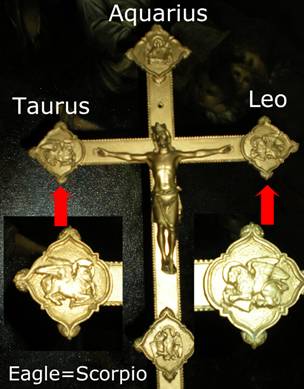
‘True Cross’ Cathedral Lisieux, France 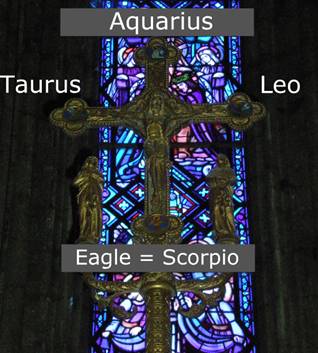
‘True Cross’, Baselique Notre Dame d’Ouvres La Delivrande, France
12 TRIBUS DE ISRAEL
  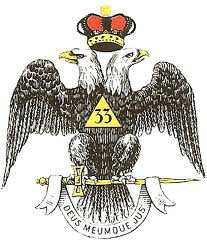 

|
Sign Type
|
Zodiac
|
Celestial Position
|
Tribe
|
Living Creature
|
|
Fire
|
Leo
|
Fall Equinox
|
Judah
|
Lion
|
|
Air
|
Aquarius
|
Spring Equinox
|
Reuben
|
Man
|
|
Water
|
Scorpio
|
Winter Solstice
|
Dan
|
Eagle
|
|
Earth
|
Taurus
|
Summer Solstice
|
Ephraim
|
Ox
|
DAN JUSTO ESTA UBICADO EN EL SOLSTICIO DE INVIERNO, CUANDO RESUCITA EL AVE PHOENIX, OSEA EL GRIAL. Observen en esta imagen inferior que justo LA CONSTELACION SAGITARIO/CAPRICORNIO esta ubicado hacia el NORTE, adonde estaba ubicada segun la tora la tribu de DAN/AGUILA/SCORPION/FLEUR DE LIS. LA "VIRGEN DE LOURDES" en el contexto a la FLEUR DE LIS esconde este mensaje esoterico. NOTE LA FORMA DE LA LETRA S/$/ DAN (TRIBU) /SERPIENTE/SNAKE/ SOPHIA/SHABBAT/ PHI/GOLDEN NUMBER QUE TIENE LA CONSTELACION DE DRACO. ESTA TODO CALCULADO PORQUE DIOS MUEVE LOS HILOS DE TODO.
 Observen QUE HERCULES PISA LA CABEZA DEL DRAGON en SCORPIONSCORPION=ORIONSE CONFIRMA QUE LOS TEMPLOS CATOLICOS ESTAN DISEÑADOS EN FUNCION AL TEMPLO DE SOL-O-MON (ORION)EL SECRETO DE LA FLEUR DE LIS, QUE CRISTO HACE REFERENCIA JUSTAMENTE EN EL CONTEXTO AL REY SOLOMON EN MATEO 6:33 CUANDO HACE REFERENCIA A LA JUSTICIA,. En la misma CATEDRAL DE SAN MIGUEL DE TUCUMAN, esta la FLEUR DE LIS, EN LA PUERTA. Observen QUE HERCULES PISA LA CABEZA DEL DRAGON en SCORPIONSCORPION=ORIONSE CONFIRMA QUE LOS TEMPLOS CATOLICOS ESTAN DISEÑADOS EN FUNCION AL TEMPLO DE SOL-O-MON (ORION)EL SECRETO DE LA FLEUR DE LIS, QUE CRISTO HACE REFERENCIA JUSTAMENTE EN EL CONTEXTO AL REY SOLOMON EN MATEO 6:33 CUANDO HACE REFERENCIA A LA JUSTICIA,. En la misma CATEDRAL DE SAN MIGUEL DE TUCUMAN, esta la FLEUR DE LIS, EN LA PUERTA.
. 1 Reyes 7:19: Los capiteles que estaban sobre las columnas en el pórtico, tenían forma de LIRIOS, y eran de cuatro codos. 2. 1 Reyes 7:22: Y puso en las cabezas de las columnas tallado en forma de LIRIOS, y así se acabó la obra de las columnas.
3. Cantares 2:16: Mi amado es mío, y yo suya; El apacienta entre LIRIOS.
4. Cantares 4:5: Tus dos pechos, como gemelos de gacela, Que se apacientan entre LIRIOS.
5. Cantares 5:13: Sus mejillas, como una era de especias aromáticas, como fragantes flores; Sus labios, como LIRIOS que destilan mirra fragante.
6. Cantares 6:2: Mi amado descendió a su huerto, a las eras de las especias, Para apacentar en los huertos, y para recoger los LIRIOS.
7. Cantares 6:3: Yo soy de mi amado, y mi amado es mío; El apacienta entre los LIRIOS.
8. Cantares 7:2: Tu ombligo como una taza redonda Que no le falta bebida. Tu vientre como montón de trigo Cercado de LIRIOS.
9. Mateo 6:28: Y por el vestido, ¿por qué os afanáis? Considerad los LIRIOS del campo, cómo crecen: no trabajan ni hilan;
10. Lucas 12:27: Considerad los LIRIOS, cómo crecen; no trabajan, ni hilan; mas os digo, que ni aun Salomón con toda su gloria se vistió como uno de ellos.
EL LIRIO ES LA FLEUR DE LIS QUE ES UNA REFERENCIA AL SCORPION
Hercules, con sus dos columnas (bandera de España), es una replica a la constelacion de GEMINIS, cercana a la CONSTELACION DE ORION. PREGUNTO: ¿QUE MENSAJE ESOTERICO HAY DETRAS DE LA UNION ESOTERICA ENTRE SCORPION Y ORION? Sabemos que el DRAGON=DRACO esta relacionado con RAHAB EN ISAIAS 30:7 y obviamene con DAN=SERPIENTE=JUSTICIA=MASHIAJ. El 911, en el contexto a la ESTATUA DE LA LIBERTAD QUE ES ORION, tiene un NEXO ESCORPIANO, y fijense que en SCORPION esta el 11 de noviembre, que tambien es un 911, en el dia numero 315 del calendario gregoriano, dandome una relacion con GENESIS 3:15 EN EL CONTEXTO A LA SERPIENTE. ESTO CONFIRMA LA RELACION DE MARADONA CON ORION YA QUE EL MISMO ES ESCORPIANO. LA FUTUROLOGIA, USANDO EL ZODIACO ES SATANICA, PERO ESTO NO NIEGA QUE EXISTA UN PATRON DE PERSONALIDAD EN FUNCION A LOS ASTROS.
|
|
|
|
Reply |
Message 39 of 216 on the subject |
|
flor de lis/scorpion
La fleur de lis, Robert Langdon y Sophie la encuentran en el contexto a una llave detras de un cuadro de Leonardo Da Vinci (Maddona y el niño/Virgen de las Rocas) en la piramide de Louvre. La fleur de lis, tiene una forma similar al escorpion, y en la tora tiene fuerte nexo con Salomon. LA PUERTA DE ORO, tiene nexo con la CONSTELACION DE SCORPION y SAGITARIO.
LA CONSTELACION DE SCORPION ANTIGUAMENTE TENIA RELACION CON EL AGUILA. LA FLEUR DE LIS tiene fuerte relacion esoterica en el CODIGO DA VINCI e incluso cuando SOPHIE Y ROBERT LANGDON, INGRESAN LA CLAVE QUE ES LA SERIE DE PHIBONACCI en un BANCO, LO HACEN CON UNA LLAVE CON LA FORMA DE LA FLEUR DE LIS. ¿CASUALIDAD O CAUSALIDAD QUE LAS CRISIS ECONOMICAS MUNDIALES SON TODAS EN OCTUBRE? HAY UN OBVIO NEXO CON EL ESCORPION. EN LA ERA DE ACUARIO, EL SOLSTICIO DE INVIERNO ES EN LA CONSTELACION DE SCORPION.

‘True Cross’ Cathedral Lisieux, France 
‘True Cross’, Baselique Notre Dame d’Ouvres La Delivrande, France
12 TRIBUS DE ISRAEL
   

|
Sign Type
|
Zodiac
|
Celestial Position
|
Tribe
|
Living Creature
|
|
Fire
|
Leo
|
Fall Equinox
|
Judah
|
Lion
|
|
Air
|
Aquarius
|
Spring Equinox
|
Reuben
|
Man
|
|
Water
|
Scorpio
|
Winter Solstice
|
Dan
|
Eagle
|
|
Earth
|
Taurus
|
Summer Solstice
|
Ephraim
|
Ox
|
DAN JUSTO ESTA UBICADO EN EL SOLSTICIO DE INVIERNO, CUANDO RESUCITA EL AVE PHOENIX, OSEA EL GRIAL. Observen en esta imagen inferior que justo LA CONSTELACION SAGITARIO/CAPRICORNIO esta ubicado hacia el NORTE, adonde estaba ubicada segun la tora la tribu de DAN/AGUILA/SCORPION/FLEUR DE LIS. LA "VIRGEN DE LOURDES" en el contexto a la FLEUR DE LIS esconde este mensaje esoterico. NOTE LA FORMA DE LA LETRA S/$/ DAN (TRIBU) /SERPIENTE/SNAKE/ SOPHIA/SHABBAT/ PHI/GOLDEN NUMBER QUE TIENE LA CONSTELACION DE DRACO. ESTA TODO CALCULADO PORQUE DIOS MUEVE LOS HILOS DE TODO.
 Observen QUE HERCULES PISA LA CABEZA DEL DRAGON en SCORPIONSCORPION=ORIONSCOR-PI-ON=PI-RAMIDE Observen QUE HERCULES PISA LA CABEZA DEL DRAGON en SCORPIONSCORPION=ORIONSCOR-PI-ON=PI-RAMIDE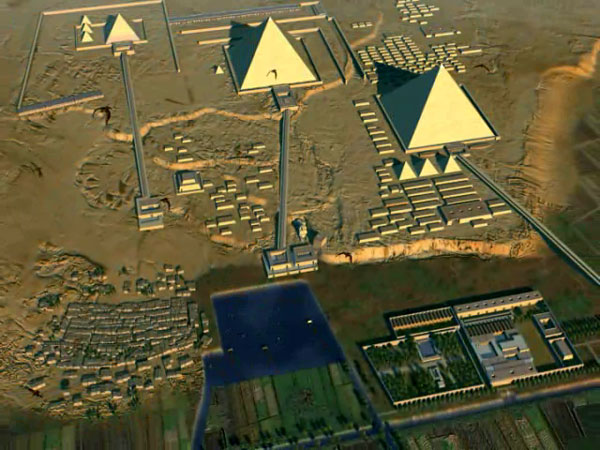 EL MISMO DISEÑO DE ORION EL MISMO DISEÑO DE ORION  SE CONFIRMA QUE LOS TEMPLOS CATOLICOS ESTAN DISEÑADOS EN FUNCION AL TEMPLO DE SOL-O-MON (ORION)EL SECRETO DE LA FLEUR DE LIS, QUE CRISTO HACE REFERENCIA JUSTAMENTE EN EL CONTEXTO AL REY SOLOMON EN MATEO 6:33 CUANDO HACE REFERENCIA A LA JUSTICIA,. En la misma CATEDRAL DE SAN MIGUEL DE TUCUMAN, esta la FLEUR DE LIS, EN LA PUERTA. SE CONFIRMA QUE LOS TEMPLOS CATOLICOS ESTAN DISEÑADOS EN FUNCION AL TEMPLO DE SOL-O-MON (ORION)EL SECRETO DE LA FLEUR DE LIS, QUE CRISTO HACE REFERENCIA JUSTAMENTE EN EL CONTEXTO AL REY SOLOMON EN MATEO 6:33 CUANDO HACE REFERENCIA A LA JUSTICIA,. En la misma CATEDRAL DE SAN MIGUEL DE TUCUMAN, esta la FLEUR DE LIS, EN LA PUERTA.
. 1 Reyes 7:19: Los capiteles que estaban sobre las columnas en el pórtico, tenían forma de LIRIOS, y eran de cuatro codos. 2. 1 Reyes 7:22: Y puso en las cabezas de las columnas tallado en forma de LIRIOS, y así se acabó la obra de las columnas.
3. Cantares 2:16: Mi amado es mío, y yo suya; El apacienta entre LIRIOS.
4. Cantares 4:5: Tus dos pechos, como gemelos de gacela, Que se apacientan entre LIRIOS.
5. Cantares 5:13: Sus mejillas, como una era de especias aromáticas, como fragantes flores; Sus labios, como LIRIOS que destilan mirra fragante.
6. Cantares 6:2: Mi amado descendió a su huerto, a las eras de las especias, Para apacentar en los huertos, y para recoger los LIRIOS.
7. Cantares 6:3: Yo soy de mi amado, y mi amado es mío; El apacienta entre los LIRIOS.
8. Cantares 7:2: Tu ombligo como una taza redonda Que no le falta bebida. Tu vientre como montón de trigo Cercado de LIRIOS.
9. Mateo 6:28: Y por el vestido, ¿por qué os afanáis? Considerad los LIRIOS del campo, cómo crecen: no trabajan ni hilan;
10. Lucas 12:27: Considerad los LIRIOS, cómo crecen; no trabajan, ni hilan; mas os digo, que ni aun Salomón con toda su gloria se vistió como uno de ellos.
EL LIRIO ES LA FLEUR DE LIS QUE ES UNA REFERENCIA AL SCORPION
Hercules, con sus dos columnas (bandera de España), es una replica a la constelacion de GEMINIS, cercana a la CONSTELACION DE ORION. PREGUNTO: ¿QUE MENSAJE ESOTERICO HAY DETRAS DE LA UNION ESOTERICA ENTRE SCORPION Y ORION? Sabemos que el DRAGON=DRACO esta relacionado con RAHAB EN ISAIAS 30:7 y obviamene con DAN=SERPIENTE=JUSTICIA=MASHIAJ. El 911, en el contexto a la ESTATUA DE LA LIBERTAD QUE ES ORION, tiene un NEXO ESCORPIANO, y fijense que en SCORPION esta el 11 de noviembre, que tambien es un 911, en el dia numero 315 del calendario gregoriano, dandome una relacion con GENESIS 3:15 EN EL CONTEXTO A LA SERPIENTE. ESTO CONFIRMA LA RELACION DE MARADONA CON ORION YA QUE EL MISMO ES ESCORPIANO PERO POR OTRA VIA.
LA FUTUROLOGIA, USANDO EL ZODIACO ES SATANICA, PERO ESTO NO NIEGA QUE EXISTA UN PATRON DE PERSONALIDAD EN FUNCION A LOS ASTROS. LA ASTROLOGIA SE USA PARA EL CRISTIANO SOLO PARA COSAS ESPIRITUALES, OSEA PROFECIAS BIBLICAS, ETC,ETC. ESTA TOTALMENTE PROHIBIDO USAR EL ZODIACO PARA EL EGO, OSEA PARA USO PERSONAL.
En la GRAN PIRAMIDE, observamos que tambien esta el PATRON DE LA CONSTELACION DEL DRAGON=DRACO. ES OBVIO QUE SCORPION tiene fuerte relacion con dicha CONSTELACION, porque la misma es ANTAGONICA A LA CONSTELACION DE TAURO/TORO. LA CLAVE DE ESTE MISTERIO ESTA EN DESCUBRIR QUE MENSAJE ESCONDE EL 11 DE NOVIEMBRE.
|
|
|
|
Reply |
Message 40 of 216 on the subject |
|
Martín de Tours (11 de noviembre=OTRO 911)
De Wikipedia, la enciclopedia libre
San Martín de Tours (Sabaria, Panonia; actual Szombathely, Hungría, 316 – Candes, actual Candes-Saint-Martin, Francia, 397) es uno de los santos más populares de la Cristiandad.
Recibió su educación en Pavía, ingresó con 15 años en la guardia imperial romana, en la que sirvió hasta el año 356 en Francia .
La leyenda más famosa en torno a su vida sucedería en el invierno de 337, cuando estando Martín en Amiens encuentra cerca de la puerta de la ciudad un mendigo tiritando de frío, a quien da la mitad de su capa, pues la otra mitad pertenece al ejército romano en que sirve. En la noche siguiente, Cristo se le aparece vestido con la media capa para agradecerle su gesto. Esta es la escena que iconográficamente se ha preferido para su representación.
Martín decide entonces dejar el ejército romano y convertirse, lo cual no puede hacer hasta pasado un tiempo, al negarle su licencia el emperador.
Tras dejar la vida militar se bautiza y se une a los discípulos de San Hilario de Poitiers en la ciudad de Poitiers.
Su festividad se celebra el 11 de noviembre, coincidiendo con la matanza del cerdo en muchas regiones de España, de ahí el origen de la expresión «A cada cerdo le llega su San Martín».
Patrono de la ciudad de Buenos Aires[editar]
Cumpliendo con una antigua tradición, don Juan de Garay y los primeros miembros del cabildo, unos días después de fundada la Ciudad, el 20 de octubre de 1580, se reunieron para darle un santo como Protector y Patrono. La suerte recayó en San Martín. La historia que tiempo después fue pasando de boca en boca hasta el día de hoy es que los vecinos, al ver el nombre de un “santo francés”, se negaron a que fuera protector de una ciudad de las colonias españolas. Reiteraron la elección, y por tres veces salió el mismo nombre, considerando de esa forma que era Dios mismo quien quería ese santo patronazgo. Lo cierto es que desde el día de la elección San Martín de Tours pasó a ser parte importante de la historia y la vida de la Ciudad de Buenos Aires.
Patrono de Utrecht[editar]
El 11 de noviembre de cada año se celebra en Utrecht, Países Bajos, el Sint Maarten (San Martín). Niños caminan por las calles con faroles hechos de papel de colores y velas por dentro, en grupos pequeños y acompañados siempre de uno o más adultos y van de casa en casa pidiendo dulces o fruta. Los niños tocan a las puertas de las casas que han dejado una vela afuera y comienzan a cantar canciones de San Martín (Sint-Maartenliedjes). La iglesia-catedral (Dom) de Utrecht fue construida en honor a San Martín.
http://es.wikipedia.org/wiki/Mart%C3%ADn_de_Tours
457. Mateo 16:18: Y yo también te digo, que tú eres Pedro, y sobre esta roca edificaré mi iglesia; y las PUERTAs del Hades no prevalecerán contra ella. 458. Mateo 24:33: Así también vosotros, cuando veáis todas estas cosas, conoced que está cerca, a las PUERTAs.
455. Mateo 7:13: Entrad por la PUERTA estrecha; porque ancha es la PUERTA, y espacioso el camino que lleva a la perdición, y muchos son los que entran por ella;
456. Mateo 7:14: porque estrecha es la PUERTA, y angosto el camino que lleva a la vida, y pocos son los que la hallan.
465. Lucas 7:12: Cuando llegó cerca de la PUERTA de la ciudad, he aquí que llevaban a enterrar a un difunto, hijo único de su madre, la cual era viuda; y había con ella mucha gente de la ciudad.
471. Juan 10:1: De cierto, de cierto os digo: El que no entra por la PUERTA en el redil de las ovejas, sino que sube por otra parte, ése es ladrón y salteador.
472. Juan 10:2: Mas el que entra por la PUERTA, el pastor de las ovejas es.
473. Juan 10:7: Volvió, pues, Jesús a decirles: De cierto, de cierto os digo: Yo soy la PUERTA de las ovejas.
474. Juan 10:9: Yo soy la PUERTA; el que por mí entrare, será salvo; y entrará, y saldrá, y hallará pastos.
Hechos 12
1. En aquel mismo tiempo el rey Herodes echó mano a algunos de la iglesia para maltratarles.
2. Y mató a espada a Jacobo, hermano de Juan.
3. Y viendo que esto había agradado a los judíos, procedió a prender también a Pedro. Eran entonces los días de los panes sin levadura.
4. Y habiéndole tomado preso, le puso en la cárcel, entregándole a cuatro grupos de cuatro soldados cada uno, para que le custodiasen; y se proponía sacarle al pueblo después de la pascua.
5. Así que Pedro estaba custodiado en la cárcel; pero la iglesia hacía sin cesar oración a Dios por él.
6. Y cuando Herodes le iba a sacar, aquella misma noche estaba Pedro durmiendo entre dos soldados, sujeto con dos cadenas, y los guardas delante de la puerta custodiaban la cárcel.
7. Y he aquí que se presentó un ángel del Señor, y una luz resplandeció en la cárcel; y tocando a Pedro en el costado, le despertó, diciendo: Levántate pronto. Y las cadenas se le cayeron de las manos.
8. Le dijo el ángel: Cíñete, y átate las sandalias. Y lo hizo así. Y le dijo: Envuélvete en tu manto, y sígueme.
9. Y saliendo, le seguía; pero no sabía que era verdad lo que hacía el ángel, sino que pensaba que veía una visión.
10. Habiendo pasado la primera y la segunda guardia, llegaron a la puerta de hierro que daba a la ciudad, la cual se les abrió por sí misma; y salidos, pasaron una calle, y luego el ángel se apartó de él.
11. Entonces Pedro, volviendo en sí, dijo: Ahora entiendo verdaderamente que el Señor ha enviado su ángel, y me ha librado de la mano de Herodes, y de todo lo que el pueblo de los judíos esperaba.
12. Y habiendo considerado esto, llegó a casa de María la madre de Juan, el que tenía por sobrenombre Marcos, donde muchos estaban reunidos orando.
13. Cuando llamó Pedro a la puerta del patio, salió a escuchar una muchacha llamada Rode,
JUAN MARCOS/
MARTE/MARTILLO/GRIAL
|
|
|
|
Reply |
Message 41 of 216 on the subject |
|
GOLDEN GATE/PUERTA DE ORO-RELACION DE FATIMA CON EL NUMERO 47
| grail in Simple Gematria Equals: 47 |
( |
g
7 |
r
18 |
a
1 |
i
9 |
l
12 |
) |
| grail in Simple Gematria Equals: 47 |
( |
g
7 |
r
18 |
a
1 |
i
9 |
l
12 |
) |
| raquel in Simple Gematria Equals: 74 |
( |
r
18 |
a
1 |
q
17 |
u
21 |
e
5 |
l
12 |
) |
| john in Simple Gematria Equals: 47 |
( |
j
10 |
o
15 |
h
8 |
n
14 |
) |
| jesus in Simple Gematria Equals: 74 |
( |
j
10 |
e
5 |
s
19 |
u
21 |
s
19 |
) |
| giza in Simple Gematria Equals: 43 |
( |
g
7 |
i
9 |
z
26 |
a
1 |
) |
| mark in Simple Gematria Equals: 43 |
( |
m
13 |
a
1 |
r
18 |
k
11 |
) |
| gize in Simple Gematria Equals: 47 |
( |
g
7 |
i
9 |
z
26 |
e
5 |
) |
| john in Simple Gematria Equals: 47 |
( |
j
10 |
o
15 |
h
8 |
n
14 |
) |
These are the four creatures of Ezekiel 1:10 and Revelation 4:7 which also relate to the four Apostles, the seasons, the elements and the guardians of the four directions.

‘True Cross’ Cathedral Lisieux, France 
‘True Cross’, Baselique Notre Dame d’Ouvres La Delivrande, France
In churches, the four signs of the Zodiac often reoccur and are associated with ‘Judgment Day’ and the ‘End of Times’
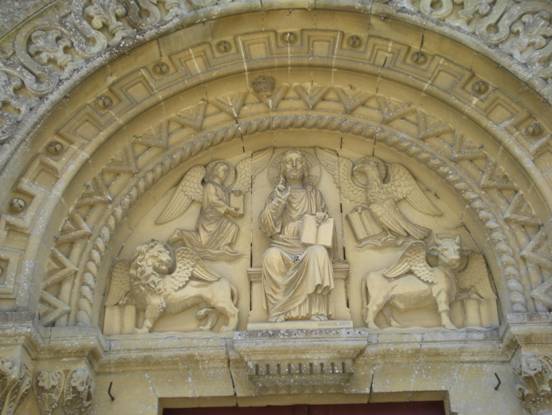
Jesus portrayed at the Last Judgment can often be found in the Tympanium above the entrance of churches and cathedrals. Notice, the lion (Leo) on the left, the bull on the right (Taurus), the angel on the left (Aquarius) and the eagle on the right ( Scorpio).
The four evangelists Luke, John, Mathew and Mark likewise have been associated with these four Zodiac signs as well:
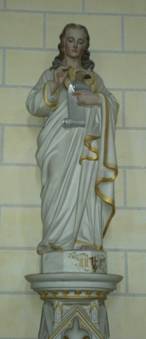 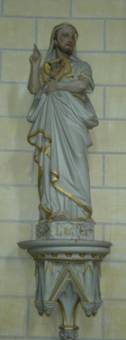 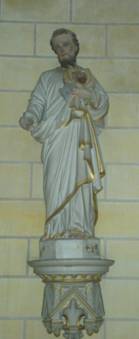 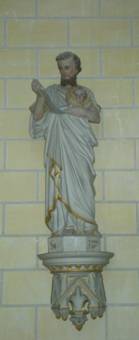
Mark = Scropio (Eagle), Luke = Taurus, John = Leo, Matthew = Aquarius
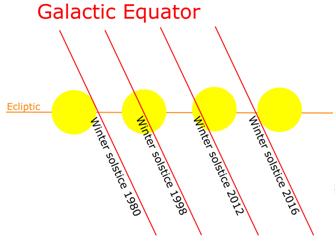 |
|
Winter Solstice Galactic Alignment of the Sun with the Galactic Equator
|
On Earth, the River Nile was the reflection of this great river in the sky, in accordance with the Hermetic principle "as above, so below." Herschel's earliest ingenious research has demonstrated that all of the pyramids along the river Nile represent constellations along the Milky Way, not just Orion! There are more than 50 pyramids in total, and their true meaning can only be deciphered when one considers the whole of Egypt.
During a Great Celestial Conjunction, the Sun crosses that great river in the sky, the Milky Way. Egyptologists explain that the solar God Ra (and Horus) required a boat because they sailed the Heavens from sunrise in the East to sunset in the West. At night, Ra travelled the Netherworld to be reborn in the morning at sunrise. Egyptologists reject the idea that the Egyptians understood the Precession of the Equinoxes and that the Sun also sojourns along the zodiac in a 26,000 year journey corresponding with the Precession Cycle.
In the Book of the Gates, the travel of the Sun at night along with the deceased pharaoh into the Netherworld is described. The Sun enters the Netherworld in the first hour just after sunset to be reborn in the morning at sunrise after a twelve hour nocturnal journey. There are many parallels, however, with the precessional journey of the Sun along the twelve signs of the zodiac to be discovered in the Book of the Gates. The 12 hours in the Book of Gates are structured into four groups of three hours, denoting a cross in the face of the clock. In the 12th hour Nun raises the solar barque with the scarab beetle of the Sun God from the primeval waters (Milky Way?), this is the hour of the rebirth of the Sun.
|
|
Left: Nun raises the solar barque from the primeval waters at ‘sunrise’, the time of the rebirth of the Sun.
|
During Ra's travel through all of the twelve signs of the zodiac in the precession cycle, he will be requiring a boat to twice cross that great river in the sky, the Milky Way! It is probably the only reason why the Egyptian deities required a Sun barque in the first place. Boats are used to cross waters, not skies, so it was used not for their nightly ecliptic travel from East to West through the Netherworld, but for their travels along the zodiac in the precession cycle. It is during this journey that the Sun would be required to cross the waters of the Milky Way at least twice. The Book of the Gates may therefore have been misinterpreted by Egyptologists as the nocturnal journey of the Sun simply because they reject the idea that the Egyptians understood Precession! Keep in mind that only twice per year on the equinox the day and night will be exactly 12 hours in length. It is therefore far more logical that the 12 hours in the Book of the Gates are in fact the 12 zodiacal Ages of the Precession Cycle.
Pharaohs in ancient Egypt were buried with their arms crossed holding Ankhs in their hands. This posture of the deceased pharaoh can be found on sarcophagus and in statues throughout Egypt. The Ankh represents a cross symbol.
|
|
Left: Grave statue of Tjel mayor of Memphis under Amenhotep III Dutch national museum of antiquities, Leiden.
Right: Sarcophagus with crossed arms and X cross on chest, Dutch National Museum of antiquities, Leiden.
|
Since the Greek inherited much of their wisdom from the Egyptians, it's more than reasonable to suspect that the gate or portal mentioned in the Book of the Gates through which the pharaoh enters the Netherworld is, in fact, the Gate of God that the Greek writer Macrobius writes about. The Gate of God was also called the Golden Gate, while the Gate of Men was called the Silver Gate. The very same Egyptian cross symbolism used by the pharaohs associated with the Golden and Silver gates of the soul (and the Sun) can still be recognized in the coat of arms of the Vatican, consisting of two crossed keys; one Golden, one Silver.
|
|
Silver and Golden cross in the Coat of Arms of the Vatican
|
The Golden Gate is the ecliptic Milky Way crossing at the Scorpio-Sagittarius nexus on the zodiac while the Silver Gate is the Milky Way ecliptic crossing at the Gemini-Taurus nexus. The Silver Gate was represented by the horns of Isis and the associated bull Taurus.
The Silver Gate is also clearly depicted in the Narmer Palette (3100 BC) named after the Egyptian pharaoh. The Narmer Palette shows the celestial goddess bull Bat (Taurus) with her horns bent over pointing exactly to the place of the rebirth of the Sun, the Silver Gate. The two cow's heads on top of the palette also represent Bat. In-between the two cow goddesses a hieroglyph is depicted representing the rising of the Sun in between two mountains on the horizon. It's a hieroglyph that is very similar to the Akhet hieroglyph with the same significance.
|
|
Bat on the left and right with the 'Akhet' glyph in between.
Dutch national museum of antiquities, Leiden
|
Bat was the goddess of the Milky Way considered to be a pool of Bat's cow milk. Bat was also the goddess of the human soul, the "Ba" that incarnated into human life form. Since the soul incarnated into human life passing through the Silver Gate (crossing of Milky Way and ecliptic), it's not surprising that Bat was both the goddess of the Milky Way and the human soul. Ba is a derivative of Bat, whereas "Ka" represents the human light-body. "Mer" represents the light of the Egyptian light-body-soul complex, the "Mer-Ka-Ba." Bat was also called the "Ba of Two Faces." Egyptologists are in the dark about her name and don't seem to understand that she was called this way, because there are actually two portals both to and from the Netherworld for the Ba to descend into the physical plane (Silver Gate) and ascend from the physical plane (Golden Gate). Both Hathor, Isis and Bat are all cow goddesses and Egyptologists have often pointed out the similarities between these goddesses depicted with cow-horns suspecting that they may have the same origins...they all represent the Silver Gate.
At the bottom of the Narmar palette in-between the horns of the bull, the very same hieroglyph is depicted as the one shown between two Bat bulls on top of the palette. This Akhet-like hieroglyph symbolises the rising Sun on the horizon.
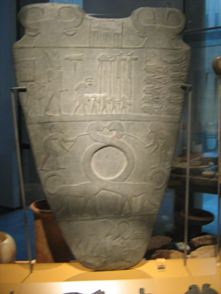 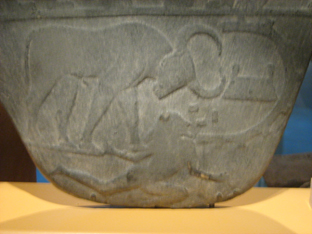 |
The Narmar Palette, bull in close up on the right. The bull is leaning towards the Silver Gate near the Gemini-Taurus nexus depicted in between the horns. The hieroglyph in between the horns resembles an Akhet glyph and represents the Silver Gate.
Dutch national museum of antiquities, Leiden
|
On the other side of the Narmer palette two identical men, hence suggesting twins are depicted. They are both looking over their shoulders to a particular square over the left man’s shoulder. We surmise that the twins represent Gemini which would make sense since the actual ecliptic Milky Way crossing of the Silver Gate occurs in 5° Gemini (sidereal zodiac) and the square could therefore be suggesting the Silver Gate.
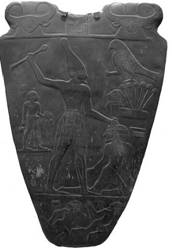 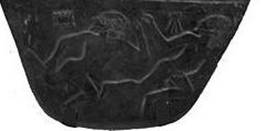
Narmer palette backside
Dutch national museum of antiquities, Leiden
The author Audrey of the website "Ancient Egypt" writes while referring to the Narmar Palette: "They present an overview of the astronomical event which occurred on September 21st in 4468BCE, when the Autumn (Fall) Equinox of the Sun was in conjunction with the Milky Way."
At the Autumnal Equinox, the Sun was indeed at the Milky Way, however at the Golden Gate. At the Vernal Equinox of 4468 BC, the Sun resided at the Silver Gate. The author (Audrey) does not seem to realise that this moment represented a Great Celestial Conjunction when the equinox axis (Vernal and Fall) aligned with the Galactic Equator and the Sun resided at the Gates of the Gods.
Instead, while interpreting the hieroglyphs of the 10 decapitated figures near the Solar Barque, he writes quote, "The full meaning of the hieroglyph can therefore be interpreted as 'the Sun at a sacred gateway, opening or portal'..."
While Hathor, Isis and Bat are all cow goddesses, Egyptologists have often pointed out the similarities between these goddesses depicted with cow-horns suspecting that they may have the same origins. . . .
We suggest that they all represent the Silver Gate.
There is an even older Egyptian goddess that later was associated with Isis and Hathor. Her name is Serket and she was the deification of the scorpion goddess who healed stings and bites. Eventually, Serket was associated with Isis and she was said to be just an aspect of Isis. Serket and Isis can therefore be regarded as the ‘Ba of Two Faces’. While Isis represents the Silver Gate at the Gemini-Taurus nexus, Serket is her counterpart and she represents the Golden Gate at the Scorpio-Sagittarius nexus. This is why she’s wearing the scorpion on her head while she joined Ra in his barque on his journey around the zodiac in a Great Year.
 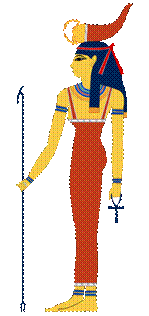
Left: Isis with the solar disk in between the horns representing the Silver Gate
Right: Serket with the scorpion at her head representing the Golden Gate.
The sacred Egyptian scarab beetle is a metaphor for the Sun in the precession cycle whereas the dung ball represents the Sun. The scarab beetle rolls its dung ball with his hind legs backwards, symbolizing the backward motion of the Sun through the zodiac in the precession cycle. Since the scarab beetle has many similarities with a scorpion, we surmise that Serket and the scarab beetle both represent the Golden Gate in Egyptian mythology.
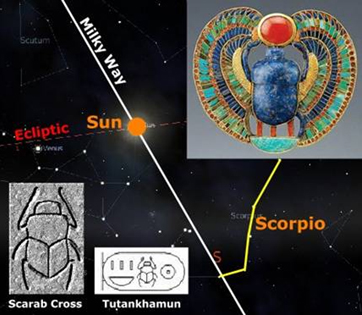
Right: Scarab representing the crossing of the ecliptic and Milky Way
near Sagittarius-Scorpio nexus. The dung ball of Scarab beetle is the Sun.
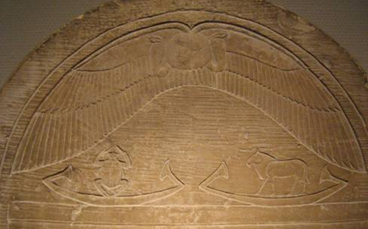
On the left, the scarab beetle in a barque. On the right, the bull with the horns in a barque. They represent the places where Ra requires a barque to cross the Milky Way river in the precession cycle and thus represents the galactic equator.
|
|
|
|
Reply |
Message 42 of 216 on the subject |
|
|
On the freemasons website that Wayne Herschel is referring to on the Key of Solomon website, the freemasons speak of the wisdom of the ancient Philosophers who regarded the soul of man to have its origins in Heaven. The soul was believed to incarnate into the flesh after having descended from Heaven passing through the Gate of Man. Having lived another live on Earth the soul eventually left the body after death and returned to Heaven again this time passing through the Gate of God. The Gate of Man corresponds with the crossing of the Milky Way and ecliptic at 5° Gemini (sidereal zodiac) while the Gate of God corresponds with the crossing of the Milky Way and ecliptic in 5° Sagittarius.
The Greek writer Macrobius called these gates on the ecliptic, through which the souls ascended and descended to Heaven, the Gates of the Sun. This is because not only mortal man but also the Sun dies and is reborn in the precession cycle at the very same gates. When the Sun resides on the gates of the Sun at an equinox or solstice, it represents a Galactic Alignment and Great Celestial Conjunction.
What happens during the 39 year period of a Great Celestial Conjunction is that the Sun at the equinox or solstice slowly shifts through the Galactic Equator of the Milky Way.
 |
|
Winter Solstice Galactic Alignment of the Sun with the Galactic Equator
|
On Earth, the River Nile was the reflection of this great river in the sky, in accordance with the Hermetic principle "as above, so below." Herschel's earliest ingenious research has demonstrated that all of the pyramids along the river Nile represent constellations along the Milky Way, not just Orion! There are more than 50 pyramids in total, and their true meaning can only be deciphered when one considers the whole of Egypt.
During a Great Celestial Conjunction, the Sun crosses that great river in the sky, the Milky Way. Egyptologists explain that the solar God Ra (and Horus) required a boat because they sailed the Heavens from sunrise in the East to sunset in the West. At night, Ra travelled the Netherworld to be reborn in the morning at sunrise. Egyptologists reject the idea that the Egyptians understood the Precession of the Equinoxes and that the Sun also sojourns along the zodiac in a 26,000 year journey corresponding with the Precession Cycle.
In the Book of the Gates, the travel of the Sun at night along with the deceased pharaoh into the Netherworld is described. The Sun enters the Netherworld in the first hour just after sunset to be reborn in the morning at sunrise after a twelve hour nocturnal journey. There are many parallels, however, with the precessional journey of the Sun along the twelve signs of the zodiac to be discovered in the Book of the Gates. The 12 hours in the Book of Gates are structured into four groups of three hours, denoting a cross in the face of the clock. In the 12th hour Nun raises the solar barque with the scarab beetle of the Sun God from the primeval waters (Milky Way?), this is the hour of the rebirth of the Sun.
|
|
Left: Nun raises the solar barque from the primeval waters at ‘sunrise’, the time of the rebirth of the Sun.
|
During Ra's travel through all of the twelve signs of the zodiac in the precession cycle, he will be requiring a boat to twice cross that great river in the sky, the Milky Way! It is probably the only reason why the Egyptian deities required a Sun barque in the first place. Boats are used to cross waters, not skies, so it was used not for their nightly ecliptic travel from East to West through the Netherworld, but for their travels along the zodiac in the precession cycle. It is during this journey that the Sun would be required to cross the waters of the Milky Way at least twice. The Book of the Gates may therefore have been misinterpreted by Egyptologists as the nocturnal journey of the Sun simply because they reject the idea that the Egyptians understood Precession! Keep in mind that only twice per year on the equinox the day and night will be exactly 12 hours in length. It is therefore far more logical that the 12 hours in the Book of the Gates are in fact the 12 zodiacal Ages of the Precession Cycle.
Pharaohs in ancient Egypt were buried with their arms crossed holding Ankhs in their hands. This posture of the deceased pharaoh can be found on sarcophagus and in statues throughout Egypt. The Ankh represents a cross symbol.
|
|
Left: Grave statue of Tjel mayor of Memphis under Amenhotep III Dutch national museum of antiquities, Leiden.
Right: Sarcophagus with crossed arms and X cross on chest, Dutch National Museum of antiquities, Leiden.
|
Since the Greek inherited much of their wisdom from the Egyptians, it's more than reasonable to suspect that the gate or portal mentioned in the Book of the Gates through which the pharaoh enters the Netherworld is, in fact, the Gate of God that the Greek writer Macrobius writes about. The Gate of God was also called the Golden Gate, while the Gate of Men was called the Silver Gate. The very same Egyptian cross symbolism used by the pharaohs associated with the Golden and Silver gates of the soul (and the Sun) can still be recognized in the coat of arms of the Vatican, consisting of two crossed keys; one Golden, one Silver.
|
|
Silver and Golden cross in the Coat of Arms of the Vatican
|
The Golden Gate is the ecliptic Milky Way crossing at the Scorpio-Sagittarius nexus on the zodiac while the Silver Gate is the Milky Way ecliptic crossing at the Gemini-Taurus nexus. The Silver Gate was represented by the horns of Isis and the associated bull Taurus.
The Silver Gate is also clearly depicted in the Narmer Palette (3100 BC) named after the Egyptian pharaoh. The Narmer Palette shows the celestial goddess bull Bat (Taurus) with her horns bent over pointing exactly to the place of the rebirth of the Sun, the Silver Gate. The two cow's heads on top of the palette also represent Bat. In-between the two cow goddesses a hieroglyph is depicted representing the rising of the Sun in between two mountains on the horizon. It's a hieroglyph that is very similar to the Akhet hieroglyph with the same significance.
|
|
Bat on the left and right with the 'Akhet' glyph in between.
Dutch national museum of antiquities, Leiden
|
Bat was the goddess of the Milky Way considered to be a pool of Bat's cow milk. Bat was also the goddess of the human soul, the "Ba" that incarnated into human life form. Since the soul incarnated into human life passing through the Silver Gate (crossing of Milky Way and ecliptic), it's not surprising that Bat was both the goddess of the Milky Way and the human soul. Ba is a derivative of Bat, whereas "Ka" represents the human light-body. "Mer" represents the light of the Egyptian light-body-soul complex, the "Mer-Ka-Ba." Bat was also called the "Ba of Two Faces." Egyptologists are in the dark about her name and don't seem to understand that she was called this way, because there are actually two portals both to and from the Netherworld for the Ba to descend into the physical plane (Silver Gate) and ascend from the physical plane (Golden Gate). Both Hathor, Isis and Bat are all cow goddesses and Egyptologists have often pointed out the similarities between these goddesses depicted with cow-horns suspecting that they may have the same origins...they all represent the Silver Gate.
At the bottom of the Narmar palette in-between the horns of the bull, the very same hieroglyph is depicted as the one shown between two Bat bulls on top of the palette. This Akhet-like hieroglyph symbolises the rising Sun on the horizon.
  |
The Narmar Palette, bull in close up on the right. The bull is leaning towards the Silver Gate near the Gemini-Taurus nexus depicted in between the horns. The hieroglyph in between the horns resembles an Akhet glyph and represents the Silver Gate.
Dutch national museum of antiquities, Leiden
|
On the other side of the Narmer palette two identical men, hence suggesting twins are depicted. They are both looking over their shoulders to a particular square over the left man’s shoulder. We surmise that the twins represent Gemini which would make sense since the actual ecliptic Milky Way crossing of the Silver Gate occurs in 5° Gemini (sidereal zodiac) and the square could therefore be suggesting the Silver Gate.
 
Narmer palette backside
Dutch national museum of antiquities, Leiden
The author Audrey of the website "Ancient Egypt" writes while referring to the Narmar Palette: "They present an overview of the astronomical event which occurred on September 21st in 4468BCE, when the Autumn (Fall) Equinox of the Sun was in conjunction with the Milky Way."
At the Autumnal Equinox, the Sun was indeed at the Milky Way, however at the Golden Gate. At the Vernal Equinox of 4468 BC, the Sun resided at the Silver Gate. The author (Audrey) does not seem to realise that this moment represented a Great Celestial Conjunction when the equinox axis (Vernal and Fall) aligned with the Galactic Equator and the Sun resided at the Gates of the Gods.
Instead, while interpreting the hieroglyphs of the 10 decapitated figures near the Solar Barque, he writes quote, "The full meaning of the hieroglyph can therefore be interpreted as 'the Sun at a sacred gateway, opening or portal'..."
While Hathor, Isis and Bat are all cow goddesses, Egyptologists have often pointed out the similarities between these goddesses depicted with cow-horns suspecting that they may have the same origins. . . .
We suggest that they all represent the Silver Gate.
There is an even older Egyptian goddess that later was associated with Isis and Hathor. Her name is Serket and she was the deification of the scorpion goddess who healed stings and bites. Eventually, Serket was associated with Isis and she was said to be just an aspect of Isis. Serket and Isis can therefore be regarded as the ‘Ba of Two Faces’. While Isis represents the Silver Gate at the Gemini-Taurus nexus, Serket is her counterpart and she represents the Golden Gate at the Scorpio-Sagittarius nexus. This is why she’s wearing the scorpion on her head while she joined Ra in his barque on his journey around the zodiac in a Great Year.
 
Left: Isis with the solar disk in between the horns representing the Silver Gate
Right: Serket with the scorpion at her head representing the Golden Gate.
The sacred Egyptian scarab beetle is a metaphor for the Sun in the precession cycle whereas the dung ball represents the Sun. The scarab beetle rolls its dung ball with his hind legs backwards, symbolizing the backward motion of the Sun through the zodiac in the precession cycle. Since the scarab beetle has many similarities with a scorpion, we surmise that Serket and the scarab beetle both represent the Golden Gate in Egyptian mythology.

Right: Scarab representing the crossing of the ecliptic and Milky Way
near Sagittarius-Scorpio nexus. The dung ball of Scarab beetle is the Sun.

On the left, the scarab beetle in a barque. On the right, the bull with the horns in a barque. They represent the places where Ra requires a barque to cross the Milky Way river in the precession cycle and thus represents the galactic equator.
Dutch national museum of antiquities, Leiden.
The most interesting of female ‘horned’ Egyptian goddesses in the Egyptian pantheon is Seshat. She was the goddess of astrology mathematics architecture and keeper of the measure of time.
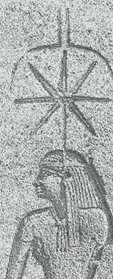
Seshat with the down turned horns and eight pointed cross.
Although interpretations differ what the cross above Seshat represents, some believe it represents a seven pointed star on a pole, other believe it represents a papyrus leaf, the authors of this article suggest that it represents an eight pointed cross, symbol of the Great Celestial Conjunction. It is placed right below the down turned horns exactly at the place where the Sun will reside during a Great Celestial Conjunction at equinoxes or solstices. Seshat headdress was called Safekh-Aubi (Sefekh-Aubi) and meant ‘She who wears the two horns’.
Seshat helped pharaoh with the alignment of the temples in Egypt in a ritual called Pedjeshes which translates into ‘Stretching the cord’ (Pedj--"to stretch," Shes--"a cord"). Armed with two pegs connected by a rope, pharaoh was accompanied by a priestess representing Seshat and aligned the temple to the celestial’s Bull’s leg while Seshat connected the other peg to her ‘home place’.
Since Seshat’s ‘home place’ is in between the horns of bull Taurus where the Sun resides at a Great Celestial conjunction and where also the eight pointed cross is depicted, the authors suggest that in the Pedjeshes alignment ritual the Pleiades as the ‘leg of the bull’ (Taurus) is being used to show the way to the place where the Sun would reside at a Great Celestial Conjunction. In this ritual the temple was aligned accordingly!
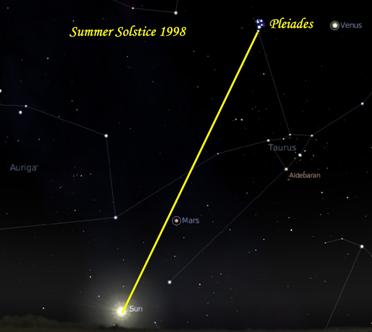 |
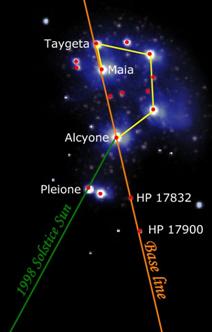 |
Pleiades as a way shower to the summer solstice Sun of 1998 (Great Celestial Conjunction era 2012)
See also Wicherink’s reinterpretation of Herschel’s conclusions on Stonehenge
Wayne Herschel mentions ‘the stretching of the rope’ ritual in his book ‘The Hidden Records’. The ‘Leg of the Bull’ (meaning the Pleiades) is mentioned in the temple of Hathor in Dendera where it is written:
“The living god Thoth – nourished by the sublime goddess in the temple – the sovereign of the country – stretches the rope in joy (align with it) – With his glance .. - ..towards the ‘ak’ of the bull’s thigh constellation.. – he establishes the temple house of the mistress of Dendera, as it took place there before”
(Wayne Herschel, The Hidden Records, pg 141)
http://www.keyofsolomon.org/gatesOfTheSun.php |
|
|
|
Reply |
Message 43 of 216 on the subject |
|
Since the scarab beetle has many similarities with a scorpion, we surmise that Serket and the scarab beetle both represent the Golden Gate in Egyptian ...
www.gabitogrupos.com/DESENMASCARANDO_LAS.../template.php?...
14/05/2012 - Since the scarab beetle has many similarities with a scorpion, we surmise that Serket and the scarab beetle both represent the Golden Gate in ...
06/05/2010 - 31 publicaciones - 3 autores
Since the scarab beetle has many similarities with a scorpion, we surmise that Serket and the scarab beetle both represent the Golden Gate in ...
Each variant of a myth represents a different symbolic perspective, enriching the ..... Texts of this type include the Amduat, the Book of Gates, and the Book of Caverns. .... This period is the closest thing to a golden age in Egyptian tradition, the .... as a child or as the scarab beetle god Khepri, both of which represent rebirth in ...
To the Egyptians, the sun represented light, warmth, and growth. ... Ra was thought to travel on two solar boats called the Mandjet (the Boat of Millions of ... Other common forms are a man with the head of a beetle (in his form as Khepri), ... In some literature, Ra is described as an aging king with golden flesh, silver bones, ...
This was also based on the belief that divine beings had flesh of gold. ... The large djed pillar painted on the back of the coffin represented a ... There was an image of a scarab beetle with outstretched wings hovering over ... The text in these books was divided according to chapters/ spells, which were almost two- hundred in ...
https://en.wikipedia.org/wiki/Book_of_the_Dead
Most sub-texts begin with the word ro, which can mean mouth, speech, a chapter of a ... Famously, two spells also deal with the judgement of the deceased in the Weighing of ... spells 6 and 126 relate to the heart, and were inscribed on scarabs. .... The deceased was required to pass a series of gates, caverns and mounds ...
hace 1 día - What I mean by that is most cameras these days have complex menu .... for while a buck pulled down by wolves can be replaced in two or three years, ... beetle, than the Golden Gate Bridge photographed in unflattering light.
In the ancient Denderah Zodiac it is represented as a Scarabaeus, or sacred beetle. ... stems from circe, meaning 'a ring' having the root as circus, circle and circuit. ... Some 300 golden bees were found stitched to the cloak of Childeric I ( the ..... These two 'Gates' are located where the Zodiac and the Milky Way intersect.
Since the scarab beetle lays its eggs in the bodies of various dead animals, including other scarabs, and in dung, from ... Both yellow VW Beetle's and Pan's gonna return later in this post. ... The movie poster represents the "flower power"- movement of the time. ... The Golden Gate is also there, as well as the lady in red.
|
|
|
|
Reply |
Message 44 of 216 on the subject |
|
|
|
|
Reply |
Message 45 of 216 on the subject |
|
|
|
Iniciado por Gabi  sí, pero cuál es su encriptación?
Salud
Buena pregunta, para mi sale de la figura del rombo dodecahedro, son dos cruces horizontales, la de arriba mas chica que la del centro, la de arriba seria coordenadas 7, 11, 13, 14 y la de abajo 3, 5, 9+6, 10, 12, la vertical el medio del arco 15, 9+6 ,0.
 |
Click para ampliar |

 |
Click para ampliar |
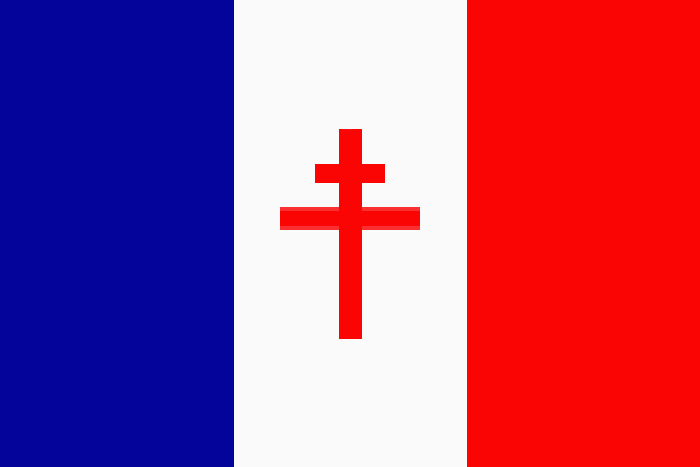 La version del concilio de Nicea tiene 3 cruces horizontales coincidiendo con el total de los cruces horizontales - verticales del diagrama de la manzana.  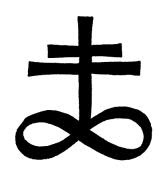 Cruz de Lorena con el nudo 8 abajo-simbologia usada por los Cataros.
Última edición por IndigoMerovingio; 30-jun-2012 a las 15:31
|
|
|
|
|
Reply |
Message 46 of 216 on the subject |
|
|
|
|
Reply |
Message 47 of 216 on the subject |
|
Rahab (demonio)
De Wikipedia, la enciclopedia libre
Para el personaje bíblico, véase Raab.
En el folklore judío, Rahab es el nombre de un demonio marino, un dragón del agua, el gobernante del mar.
Rahab es mencionado en el Talmud y en el Antiguo Testamento, se le ha dado la etimología de escándalo, tumulto y arrogancia.
Su nombre original era el abismo primordial, el dragón marino de la oscuridad y el caos, era comparable al Leviatán y a Tiamat. Más tarde Rahab llegó a ser un demonio especial, habitante del mar, especialmente asociado al Mar Rojo, en este caso algunas veces asociados con el Leviatán.
En la tradición hebrea[editar]
Rahab es o era el ángel de la insolencia y el orgullo, es responsable de agitar las aguas y producir las olas, el también es responsable de la tempestades del mar, de acuerdo con algunas fuentes el era el ángel guardián de Egipto, una posición a menudo designada a otros angeles tales como Belial, Mastema, Samael y Uzza. Rahab representa el caos en textos antiguos tales como la Biblia.
== Referencias culturales ==(rahab) Hay varios personajes de videojuegos llamados Rahab y tiene las características
http://es.wikipedia.org/wiki/Rahab_(demonio)
|
|
|
|
Reply |
Message 48 of 216 on the subject |
|
Rabá
1. Ciudad con aldeas asociadas en la zona montañosa de Judá (Jos. 15.60), posiblemente la Rubute de las cartas de Amarna y Tutmosis III, que se encontraba en la región de Gezer.
2. Capital de Amón, ahora Ammán, capital de Jordania, 35 km al E del río Jordán. Su nombre completo aparece en Dt. 3.11; 2 S. 12.26; 17.27; Jer. 49.2; Ez. 21.20 como “Rabá de los hijos de Amón” (rabbat bƒneÆ ammoÆn) que se abrevia Rabá (rabbaÆ) en 2 S. 11.11; 12.27; Jer. 49.3, etc. Evidentemente este nombre significa “ciudad principal” (LXX tiene akra, ‘ciudadela’, en Dt. 3.11). El ataúd (°nbe “sarcófago”) de hierro de Og, rey de Basán, se encontraba allí (Dt. 3.11; °vrv2 “cama de hierro”).
El poderío amonita creció simultáneamente con el israelita, de modo que David tuvo un rival en Hanún, hijo de Nahas. Después de derrotar a los aliados arameos de Hanún y al ejército amonita, David y Joab pudieron invadir Amón; Joab sitió Rabá, pero dejó a David el honor de tomar la ciudadela. Los habitantes fueron obligados a realizar trabajos forzados (2 S. 10; 12.26–31; 1 Cr. 20.3). Después de la muerte de Salomón, Amón reafirmó su independencia y perturbó a Israel. Los profetas hablaron contra Rabá como representativa del pueblo de Amón (Jer. 49.2–3; Ez. 21.20; 25.5; Am. 1.14).
Rabá, reedificada y rebautizada Filadelfia por Tolomeo Filadelfo (285–246 a.C.), formó parte de la Decápolis y fue un importante centro comercial.
Considerables reliquias arqueológicas existen hoy en la vecindad de Ammán. En el aeropuerto se ha desenterrado un edificio del ss. XIII a.C. (edad del bronce tardía). Se usaba como depósito para restos humanos cremados, muchos de ellos de niños pequeños, tal vez sacrificados a *Moloc. Encima de la ciudadela misma hay extensas ruinas de las ciudades de las épocas medieval, bizantina, romana, y helenística, y en ellas se han encontrado esculturas e inscripciones de los ss. VIII y VII a.C. También se han encontrado rastros de una fortificación de la edad del bronce tardía.
Bibliografía. A. Díez Macho, “Rabbat ‘Ammón”, °EBDM, t(t). VI, cols. 81–85; C. F. Pfeiffer, “Ammán”, °DBA, pp. 39–40.
F. M. Abel, Géographie de la Palestine, 2, 1933, pp. 423–425; G. L. Harding, Antiquities of Jordan, 1967, pp. 61–70; J. B. Hennessy, PEQ 98, 1966, pp. 155–162; C. M. Bennett, Levant 10, 1978, pp. 1–9.
|
|
|
|
Reply |
Message 49 of 216 on the subject |
|
|
|
|
Reply |
Message 50 of 216 on the subject |
|
LLAVE DE DAVID/SALOMON/ SEÑAL DE JONAS / REINA DE ETIOPIA/ GIZE / ORION / IGLESIA COPTA / JUAN MARCOS
|
|
|
|
Reply |
Message 51 of 216 on the subject |
|
De la esclava de Raquel, Jacob tuvo otros dos hijos:
10.10) Dan, Dã.
Escorpión: «serpiente junto al camino, víbora junto a la senda, que muerde los talones del caballo».Forma abreviada de Daniel «Dios me ha hecho justicia».[22]En su Bendición, Dan hijo de Jacob es llamado serpiente (nachash, según la concordancia Strong, 5175;) y víbora (shephiyphon, 8207).Dan, se dice, morderá los talones de un caballo y hará a su jinete que se caiga hacia atrás en el camino. La palabra utilizada para jinete, rakab (pronunciado rakáb), es un juego de palabras con Rahab (pronunciado rajáb), un epíteto de la Diosa Madre.
y a su raza, y es caracterizado como un agresor despreciable y venenoso que no permitirá que una criatura más avanzada le pase por encima sin ser molestado. Como una víbora, se mueve por la tierra lentamente. Rahab cabalga velozmente en su gran caballo.En fenicia y Siria, al dios sol se le llamaba Dan-El.Su tribu ocupaba inicialmente la franja mediterránea de Canaán, junto a los filisteos; luego se trasladó al Norte de Israel (Jueces 18). Según el canto de Débora (Jueces 5) se enfatiza sus orígenes marineros.[23] Los filisteos efectivamente se identifican con uno de los llamados «pueblos del mar», pero no era el único. Los Danuna eran otro de los pueblos, siendo como un vestigio de los danois griegos. En el 1.190 aparecen por primera vez en los registros egipcios, bajo el reinado de Ramsés III (fecha anterior al Canto de Débora). Pareciera como si efectivamente hubieren llegado conjuntamente con los filisteos y luego se hubieran distanciado de ellos, hubieran sido perseguidos y se hubieran radicado al norte de Israel, acogiéndose a la confederación israelita (¿buscando seguridad y protección?)[24]. Otra pista, un famosos danita fue Sansón, quien efectivamente pasaba su tiempo con filisteos.
|
|
|
 First First
 Previous
37 a 51 de 216
Next Previous
37 a 51 de 216
Next Last
Last
|

